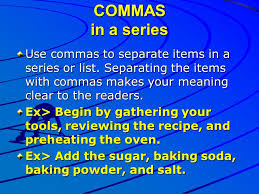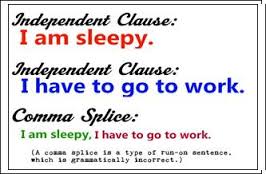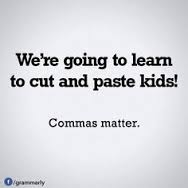Overview
Commas separate parts of a sentence grammatically, as well as separate items in a series. Without commas separating clauses, some of the meaning can be changed or lost.
Commas in Series
Use commas to separate each word, clause, or phrase in a series of three or more. For example, “She bought bread, milk, eggs, and coffee at the store.” Similarly, “The witness promised to tell the truth, the whole truth, and nothing but the truth.” Do not use a comma if there are only two items in a series, such as “The only items on the shopping list were bread and milk.”
Commas after Independent Clauses
Use commas to separate independent clauses if they are joined by a coordinating conjunction and, but, for, nor, or, so, or yet. For example, “The actors took their bows, and the audience gave them a standing ovation.” If independent clauses are joined by a comma without a coordinating conjunction, they are a type of run-on sentence called a comma splice. Comma splices can be corrected by selecting the appropriate coordinating conjunction, using a semicolon, or making each independent clause a separate sentence.
Commas after Dependent Clauses
If a dependent clause or prepositional phrase occurs at the beginning of a sentence, followed by an independent clause, use a comma to separate them. For example, “After eating, the couple walked several blocks.” Without the comma, the sentence is very confusing. “After eating the couple walked several blocks.” The comma would not be necessary if the prepositional phrase were at the end of the sentence, as in, “The couple walked several blocks after eating”. Similarly, a sentence such as “While the train stood at the siding, the engineer inspected the cars” is clearer with the comma than without it.
Commas Isolating Phrases
Use commas at the beginning and end of phrases to separate elements of appositive phrases from the rest of the sentence. An appositive phrase is not essential to the meaning of the sentence and describes a noun with more detail, such as “Ms. Jones, the company CEO, introduced the next speaker.” The sentence would make sense if it read, “Ms. Jones introduced the next speaker” or “The company CEO introduced the next speaker.”
Interested in English tutoring services? Learn more about how we are assisting thousands of students each academic year.
SchoolTutoring Academy is the premier educational services company for K-12 and college students. We offer tutoring programs for students in K-12, AP classes, and college. To learn more about how we help parents and students in Atlantic City, NJ: visit: Tutoring in Atlantic City, NJ





